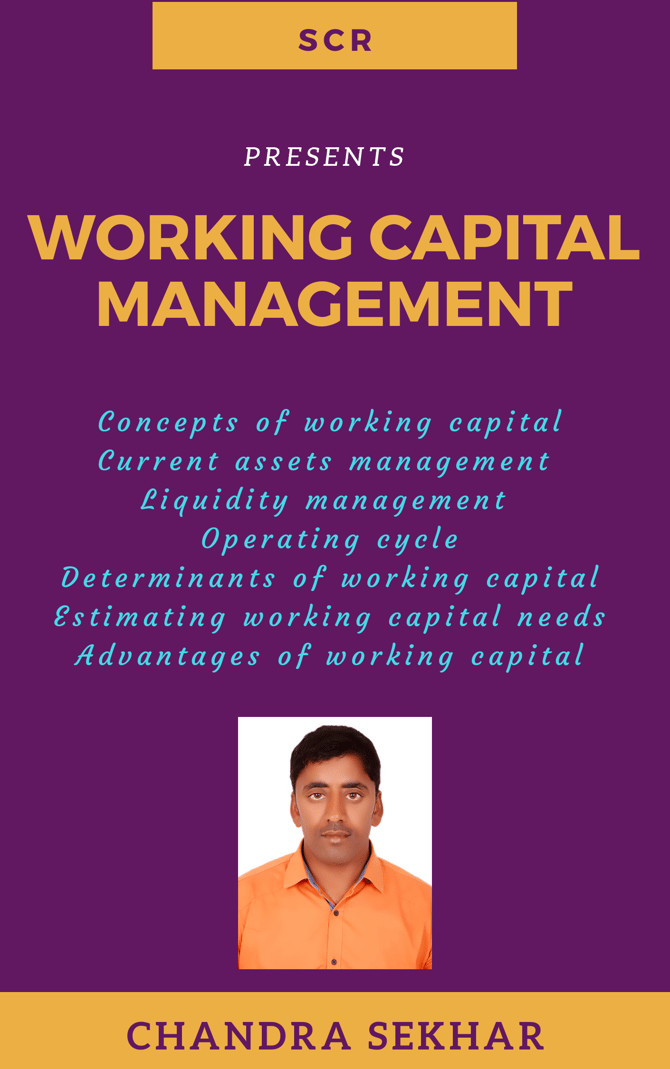
WORKING CAPITAL MANAGEMENT
I wrote this book Woking capital management with the following objectives.
· To demonstrate to readers that the subject of Woking capital management simple to understand, relevant in practice and interesting to learn.
· To help managers appreciate the logic for making better financial decisions.
· To explain the concepts and theories of Woking capital management in a simple way so readers could grasp them very easily and be able to put them in to practice.
· To provide a book that has a comprehensive coverage for ratios and their analysis.
· To create a book that differentiates itself from other books in terms of coverage, presentation.
This book useful to Students, Job Interviews, Investors, Financial advisers, Financial managers and Fund managers to relate theories, concepts and data interpretation to practice.
This book Woking capital management aims to assist the reader to develop a thorough understanding of the concepts and theories underlying financial management in a systematic way. To accomplish this purpose, the recent thinking in the field of finance has been presented in a most simple, and precise manner.
The main features of the book are simple understanding and key concepts.
The book contains a comprehensive analysis of topics on Woking capital management with a view that readers understand financial decisions thoroughly well and are able to evaluate their implications for shareholders and the company.
This book begins with the discussion of Introduction of Woking capital management. With this foundation, readers can easily understand the ratios, decision criteria necessary to manage the funds and create and enhance the value of the firm.
The text material has been structured to focus on Woking capital management is in the financial decision making process.
The book discusses the theories, concepts, assumptions, underlying financial decisions i.e. investment, financing, dividend and working capital management.
It is hoped that this will facilitate a better understanding of the subject matter.
CONTENTS
1. Introduction
2. Concepts of working capital
Gross working capital
Net working capital
3. Current assets management
4. Liquidity management
Measures of liquidity
Current ratio
Liquid ratio
Net working capital ratio
5. Operating cycle
Types of operating cycle
Gross operating cycle
Inventory conversion period
Raw material conversion period
Work-in-progress conversion period
Finished goods conversion period
Debtors conversion period
Net operating cycle
Creditors deferral period
6. Statement of Cost of sales
7. Permanent and variable working capital
8. Balanced working capital maintain
Excessive working capital
Inadequate working capital
9. Policies for financing current assets
Short-term financing
Long-term financing
Spontaneous financing
10. Estimating working capital requirement
Methods of estimating WC requirement
Current assets holding period
Ratio of sales
Ratio of fixed investment
11. Factors influencing working capital
12. Advantages of working capital
13. Problems and Solutions
Case 1 and solution
Case 2 and solution
Case 3 and solution
Case 4 and solution
Case 5 and solution
· To demonstrate to readers that the subject of Woking capital management simple to understand, relevant in practice and interesting to learn.
· To help managers appreciate the logic for making better financial decisions.
· To explain the concepts and theories of Woking capital management in a simple way so readers could grasp them very easily and be able to put them in to practice.
· To provide a book that has a comprehensive coverage for ratios and their analysis.
· To create a book that differentiates itself from other books in terms of coverage, presentation.
This book useful to Students, Job Interviews, Investors, Financial advisers, Financial managers and Fund managers to relate theories, concepts and data interpretation to practice.
This book Woking capital management aims to assist the reader to develop a thorough understanding of the concepts and theories underlying financial management in a systematic way. To accomplish this purpose, the recent thinking in the field of finance has been presented in a most simple, and precise manner.
The main features of the book are simple understanding and key concepts.
The book contains a comprehensive analysis of topics on Woking capital management with a view that readers understand financial decisions thoroughly well and are able to evaluate their implications for shareholders and the company.
This book begins with the discussion of Introduction of Woking capital management. With this foundation, readers can easily understand the ratios, decision criteria necessary to manage the funds and create and enhance the value of the firm.
The text material has been structured to focus on Woking capital management is in the financial decision making process.
The book discusses the theories, concepts, assumptions, underlying financial decisions i.e. investment, financing, dividend and working capital management.
It is hoped that this will facilitate a better understanding of the subject matter.
CONTENTS
1. Introduction
2. Concepts of working capital
Gross working capital
Net working capital
3. Current assets management
4. Liquidity management
Measures of liquidity
Current ratio
Liquid ratio
Net working capital ratio
5. Operating cycle
Types of operating cycle
Gross operating cycle
Inventory conversion period
Raw material conversion period
Work-in-progress conversion period
Finished goods conversion period
Debtors conversion period
Net operating cycle
Creditors deferral period
6. Statement of Cost of sales
7. Permanent and variable working capital
8. Balanced working capital maintain
Excessive working capital
Inadequate working capital
9. Policies for financing current assets
Short-term financing
Long-term financing
Spontaneous financing
10. Estimating working capital requirement
Methods of estimating WC requirement
Current assets holding period
Ratio of sales
Ratio of fixed investment
11. Factors influencing working capital
12. Advantages of working capital
13. Problems and Solutions
Case 1 and solution
Case 2 and solution
Case 3 and solution
Case 4 and solution
Case 5 and solution

